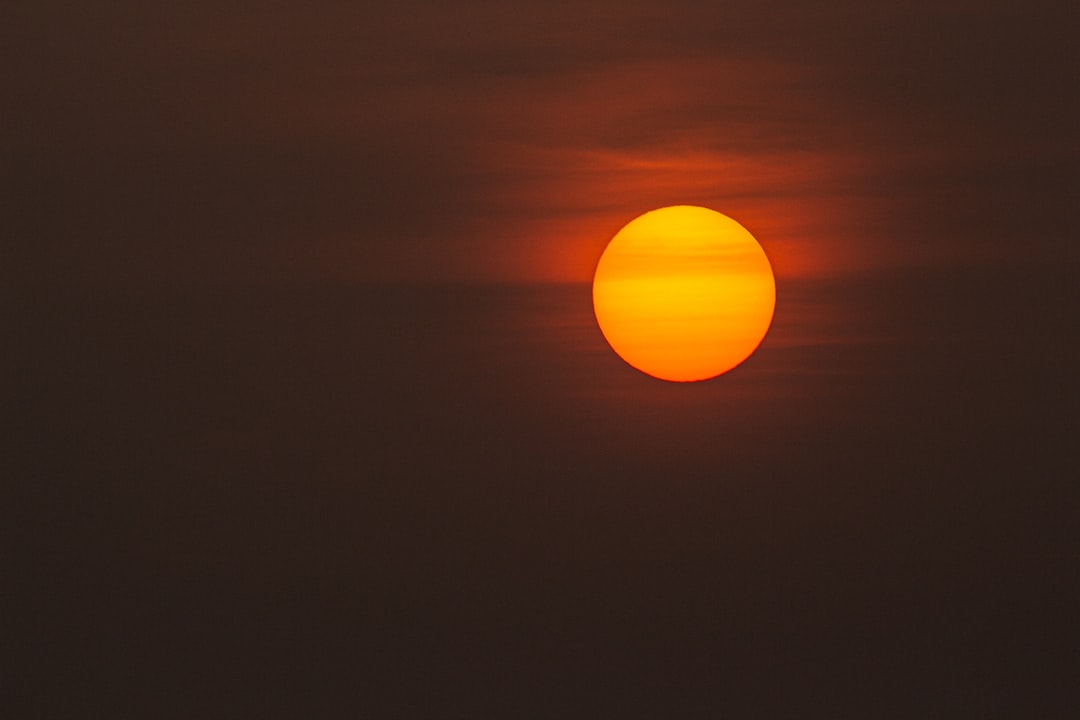When we think of stars, most people think of the twinkling dots of light in the night sky. There is a much closer and much brighter star which you can see in the daytime, however: the Sun. If you ever want to thank your lucky stars, don’t forget to include the Sun!
Our personalized star maps are a great way to connect to a moment in the past by plotting the precise locations of the stars in the night sky. As we are orbiting the sun, we remain roughly the same distance from it all year round and the time of day will tell you where you were in relation to it. There’s not such a need to include it, therefore.
It’s important to pay homage to our nearest and dearest star, however, and so let’s take a deep dive into the sun (metaphorically speaking!) to find out all about it. Introducing the top 50 facts about the Sun!
1 - The sun is 4.6 billion years old.
2 - The sun has a diameter of 1,392,684 km and an equatorial distance of 4,370,005.6 km. It makes Earth look small, very small. In fact, 1.3 million Earths could fit inside the sun.
3 - The Sun’s mass is 333,000 times the mass of the Earth.
4 - The Sun is a ball of gas: it has no solid surface, unlike the Earth. Its density decreases exponentially with increasing distance from its centre.
5 - We all know the sun is hot, but just how hot? To give you an idea, the average surface temperature of the Earth hovers around 17 °C. The average surface temperature on the sun, however, is 5,500 °C.
6 - The temperature inside the sun makes the surface temperature look cold: it can be as hot as 15 million °C.
7 - The Sun is as bright as 4 trillion 100-watt light bulbs. Imagine paying for that energy bill!
8 - The sun remains an average distance of 150 million kilometres from the Earth. This is 391 times further away than the moon.
9 - The sun’s light takes 8 minutes to reach Earth.
10 - The Sun is 99.86% of the Solar System’s mass and it has roughly 330,000 times more mass than the Earth.
11 - The Sun is closest example of a perfect sphere we have so far discovered in nature. There is only a 10-kilometre difference between the Sun’s equatorial and polar diameter.
12 - The Sun is a second-generation star and so it is partly made out of other stars.
13 - The Sun is approximately half-way through its lifespan. It is currently 4.7 billion years old and has enough hydrogen to burn for another 5 billion years.
14 - The Sun burns approximately four million tonnes of hydrogen every second.
15 - The Sun creates its energy through a process known as nuclear fusion.
16 - The heat and light released from the core of the Sun (initially as gamma rays) takes approximately one million years to reach its surface.
17 - As well as heat and light, the Sun also produces a low-density stream of charged particles which we call the solar wind. Solar winds spread throughout the universe at 450 kilometres per second.
18 - After all the hydrogen in the Sun has burned out, it will burn its helium for another 130 million years. Over this time, the Sun will expand to engulf Mercury, Venus and Earth, becoming a red giant. If humans are still alive at this time, they will need to find another planet to survive!
19 - The Sun is currently a yellow dwarf star. Towards the end of its life it will become a red giant and then a white dwarf.
20 - Eventually, the Sun will cool to become a black dwarf. If you want to learn more about the lifecycle of stars, check out our Ultimate Star Quiz. You’ll find the answer to this and many more interesting facts about the stars!
21 - When the Sun has collapsed to a white dwarf star, it will be approximately the same volume as Earth, but keep its ginormous mass.
22 - The Sun orbits the centre of the Milky Way. It takes the Sun approximately 250 million years to complete a cycle. So far, the Sun has circled the Milky Way 18 times over its lifetime.
23 - The Sun is 30,000 light years away from the centre of the Milky Way.
24 - The Sun is travelling at 220 kilometres per second. That means the sun travels 7.33 times faster than the Earth. The Earth’s orbital speed is 30 kilometres per second.
25 - The Sun completes a rotation every 25-35 days. Of course, it’s always daytime on the sun!
26 - The Sun is composed of 92% hydrogen, 7% helium and 1% other gasses. Six ten-billionths of the Sun are made of gold!
27 - The atmosphere of the Sun has three parts: the photosphere, chromosphere and the solar corona.
28 - Near the sunspots, sudden bursts of brightness can appear called solar flares.
29 - Solar flares are caused by magnetic fields of the Sun colliding.
30 - The amount of energy released by a solar flare is equivalent to an explosion of millions of 100-megaton hydrogen bombs. This is ten million times greater than the energy released during a volcanic explosion but less than a tenth of the total energy emitted by the sun every second.
31 - Every second the Sun emits more energy than humans have used in the last 10,000 years. If only we could harness this energy more, we wouldn’t need to burn so many fossil fuels!
32 - Every day, plants convert sunlight into energy, consuming the equivalent of six times the power that has been used in all of human history.
33 - The sun has two forms of radiation: electromagnetic (photons) and particle (electrons, protons, alpha particles and others) radiation.
34 - The sun emits three kinds of energy: infrared radiation, visible light and ultraviolet light.
35 - The Earth’s ozone layer absorbs most of the harmful UV radiation from the Sun. It’s not all bad, however. The Sun’s UV rays also have antiseptic properties.
36 - Skylab was the first manned spacecraft to study the Sun in February 1974.
37 - Many ancient civilizations have centred their culture and religion around the Sun, including the Aztecs (sun gods: Tonatiuh and Huitzilopochtli), Incas (sun god: Inti), Egyptians (sun god: Ra), Greeks (sun gods: Helios and Apollo), Japanese (sun goddess: Amaterasu) and many more.
38 - The sun gods of the Aztec religion demanded regular human sacrifices.
39 - Your weight on the Sun would be 27 times your weight on Earth so if you weigh 75 kilos on earth, your weight would be 2,025 kilos on the Sun.
40 - Anaxagoras, a scientist and philosopher from modern-day Turkey, was the first to theorize the Sun was in fact a star in 450 BC.
41 - Every 11 years, the Sun’s magnetic polarity reverses. The north pole becomes the south pole and the south pole becomes the north pole.
42 - Isaac Newton proved the Earth orbited the Sun (and not the other way around), but Copernicus argued this in the 16th century and the Greek philosopher, Aristarchus, was the first to suggest this.
43 - The gravity of the Sun anchors the Earth and all the other planets together in the Solar System.
44 - Without the Sun, the Earth would travel in a straight line.
45 - Without the Sun, there would be no life on Earth. The Sun produces energy that supports all life through a process known as photosynthesis.
46 - There is a bubble surrounding the sun and the solar system called the heliosphere.
47 - The study of the interior of the Sun is known as helioseismology.
48 - Due to a phenomenon known as atmospheric scattering, the Sun appears to change colour through the day, but it is actually a mixture of all the colours.
49 - In space, the Sun would appear white to us, not yellow.
50 - The parts of the Sun which are relatively cooler appear darker. These are known as sunspots. They are cooler because they have a strong magnetic field, preventing the convection of energy.
The Sun: Latest News
The facts haven’t stopped coming in about the Sun yet! We’re still discovering so much about it. In fact, just this month the British-built spacecraft, “The Solar Orbiter”, sent back the closest every images of the Sun. The probe passed by the Sun from a distance of 47 million miles, about half the distance between the Sun and the Earth. That may sound like a long way away (and it is!), but it is still phenomenally hot at that distance and designing a spacecraft to withstand the Sun’s searing heat (and the freezing cold on the far side of the probe) is no easy task.
The incredible photos taken by The Solar Orbiter have brought yet further questions and answers to us. It is hoped that these photos could solve one of the greatest mysteries: why the Sun’s atmosphere is hotter than its surface temperature. They have found strange mini-flares on the surface of the Sun dubbed “campfires”. Adding these millions of “campfires” to the solar flares which they already knew about could finally explain the difference in atmospheric and surface temperature.
Without the Sun, we literally would not be here so next time you look at a map of the stars, don’t forget the Sun!



